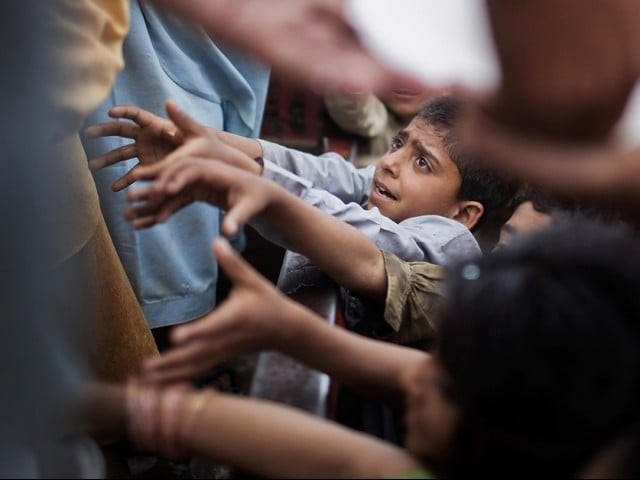Data controversy: Numbers show a decline in poverty
Availability of data online will further enhance transparency of poverty estimates

PHOTO: REUTERS
Pakistan has a strong tradition of measuring incidence of poverty in the country since 1960s.
The credibility of Pakistan’s poverty number is well established as the government is not the only entity which is measuring poverty. There are many researchers who estimate poverty in their private or institutional capacities.
Estimates became controversial in 2008 after which there was a long impasse of official poverty estimates which lasted till 2016. An independent committee of experts was constituted by the government in 2012 to review the official methodology used in surveys of poverty. The government also sought help from the World Bank to learn about best international practices. Finally, it came up with a poverty number in April 2016 which was made public.
The government went one step ahead and engaged with provincial governments and academia for publishing multidimensional poverty index (MPI). In June 2016, the Planning Commission published a district-wise profile of poverty and its dynamics which would help in assessing the effectiveness of public money. This information was presented in all divisional headquarters of the four provinces and consultations were held to further improve the outcome of the MPI.
To improve transparency in the entire process, the government, for the first time, has made the household level micro-data public. Now any researcher can download the entire data from the website of Pakistan Bureau of Statistics (PBS). The government has also decided to build capacity in and outside the government and to this end a quality training exercise according to international standards was organised by the Planning Commission. This was not only attended by officials from the federal and provincial governments but also by researchers from universities of all 4 provinces. This training was held in September 2017.
Now, the spread of poverty in the country will not only be estimated by the government but also by more than 30 well-trained academicians. Analytical capacity was also developed through the exercise to promote knowledge about poverty dynamics.
Has poverty increased or decreased
There are some global definitions of poverty which are used for international comparison. Definitions used by the World Bank and the United Nations Development Fund are the most popular.
The World Bank defines people earning less than $1.9 a day to be below the poverty line while the multidimensional poverty index considers factors other than income as well. According to both measures, poverty has declined in Pakistan during the last one decade. It has decreased even when economic growth was not very high. Inequality was a concern for Pakistan in the past but to our surprise Pakistan is one of only a few countries where inequality measured by GINI coefficient has improved.
There are several reasons for this anomalous development and one reason is that during the last decade remittances from Middle East have witnessed exponential growth while those from North America and Europe have grown at a slower pace. Remittances from the Middle East are normally destined for relatively poor families as compared to remittances from the West which find their way to affluent families. The growth of income in lowest quintiles is much higher than highest quintiles.
The national definitions like cost of basic needs (CBN) and MPI also support the claim of a fall in poverty in recent years. Both these methods evolved in the global arena and subsequently adopted by Ministry of Planning. The narrative developed by some sections of media is that the government is shying away from releasing latest power numbers is simply ridiculous as there is nothing to hide.
The PBS has released the micro-data on its website and think tank Social Policy and Development Center has already calculated its poverty number from it and made it public.
The poverty number released by the government is widely quoted and its thorough accountability is done by researchers. The government could not afford to release numbers without proper scrutiny. There are anecdotal evidences available from the data released by the PBS, economic data, social development etc. One thing is very clear that poverty has not increased in recent years primarily because of socio-economic development in the country. World Economic Forum’s data of last year suggests that Pakistan has done a lot to enhance inclusiveness of economic growth which is likely to decrease poverty. Pakistan climbed by 9 notches on inclusivity of economic growth during the last 2 years.
Regarding the government’s introduction of social safety nets, the Benazir Income Support Program (BISP) is regarded as the best program of cash disbursement in the region. A new National Database registry is being developed at the Tehsil level to incorporate information of all deserving persons in the database.
Things are happening at provincial and federal levels in a discrete manner but social transformation is also slow to emerge at the surface. Poverty is not a challenge just for the government but also for the rest of the society and the government’s response is marginal compared to the society’s efforts. It must be looked at in this perspective. Private philanthropy represents the biggest chunk of poverty alleviation efforts.
The writer is Chief of Poverty Alleviation and SDGs Section of the Ministry of Planning, Development and Reform
Published in The Express Tribune, February 12th, 2018.
Like Business on Facebook, follow @TribuneBiz on Twitter to stay informed and join in the conversation.



















COMMENTS
Comments are moderated and generally will be posted if they are on-topic and not abusive.
For more information, please see our Comments FAQ